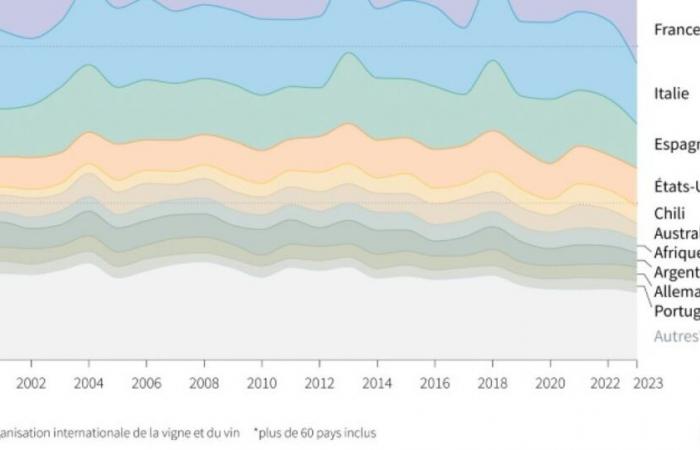Here drought, there late frost, elsewhere continuous rain… World wine production should fall in 2024 to its lowest level since 1961, under the effect of bad weather which hit the Southern hemisphere as well as the North, estimates the International Organization of Vine and Wine (OIV).
The overall harvest is expected between 227 and 235 million hectoliters (mhl), the lowest volume since 1961 (220 mhl), these projections indicate on Friday based on the harvests of 29 countries representing 85% of production last year. .
With an average projection of 231 mhl, it is still expected to be down 2% compared to the bad year 2023 (237 mhl) and 13% below the average of the previous ten years.
“Climatic challenges across both hemispheres are once again major causes of this reduced production volume,” underlines the OIV, which notes that most regions have suffered.
Europe expects “a low level of production”, with only Portugal and Hungary maintaining levels close to their average.
The European harvest is thus 11% below the average of the last five years. “If it were confirmed, it would be the weakest of this century,” said Giorgio Delgrosso, head of the OIV statistics division, on Friday.
– Italy ahead of France –
Italy, which with 41 million hectoliters is doing better than its “very low volumes of 2023”, regains the place of first world producer.
France, affected by precipitation and diseases, on the other hand experienced in 2024 the most marked decline from one year to the next among all these countries (-23%, to 36.9 mhl), and returned to second position, underlines the OIV, an intergovernmental organization which is celebrating its hundredth anniversary this year. Spain is in 3rd place, with a slightly improved record in one year.
The United States, the 4th largest producer in the world, has an average harvest of 23.6 mhl, slightly below 2023.
In the Southern Hemisphere, where the harvest ended in April-May, volumes are the lowest in two decades, again due to climatic conditions.
Previously these regions (around 20% of the world total) tended to counterbalance the general balance when the Northern hemisphere suffered, underlines to AFP the director of the OIV, the New Zealander John Barker, who notes a “general volatility increased in recent years.
“The impacts of climate change are accumulating, and being concerned about the climate and sustainability is crucial for the future,” he insists, also noting that the year’s harvest, although reduced, is “of quality”.
“We are clearly in a difficult moment for many within the sector, a moment of change and uncertainty,” underlines the director of the OIV, an organization of 51 states sometimes nicknamed “the UN of wine”.
But “change is a constant” in the sector, he stressed, presenting to the press statistics from 100 years of wine culture and trade.
It “has experienced significant transformations in its production methods, its market structures, its geographies, its consumption patterns… And ultimately they have been positive in terms of value and scope.”
But it's not just the climate: “understanding changes in consumer behavior and the position of wine in society” is another challenge, said Mr. Barker.
In fact, over the first half of 2024, global wine consumption declined further, affected in particular by profound changes in consumer preferences: -3.9% in volume over one year (-20.1% compared to the 1st half of 2024). semester 2019), indicates IWSR.
According to this alcohol data analyst, prosecco was the only category to grow in the first six months of this year (+5%), due in particular to its accessibility. At the same time, champagne, for example, fell by 8.6%.






